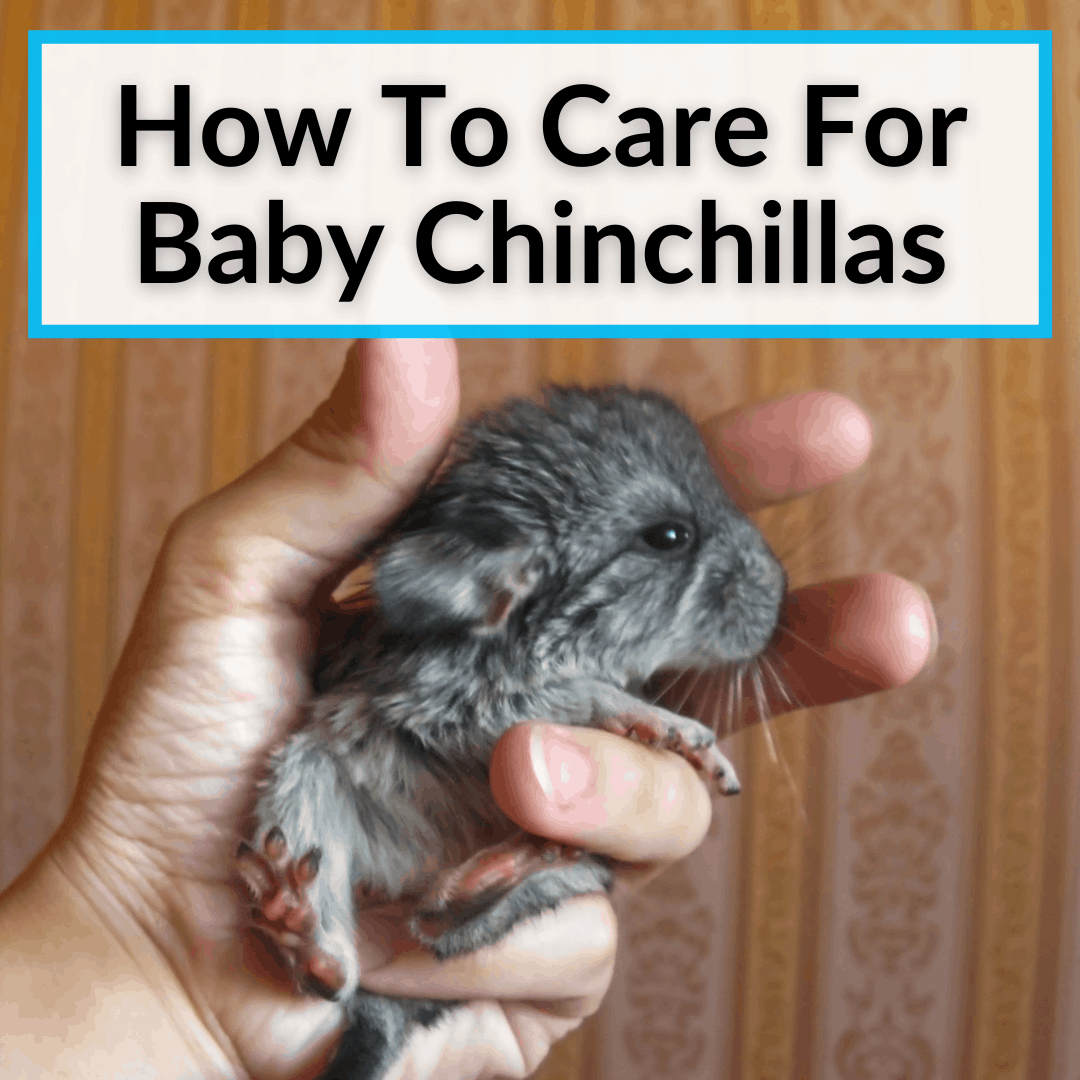
Even more so than the adults.
So it only makes sense to want to adopt a baby and watch it grow up in front of your eyes.
But baby chinchillas are different from adults.
It is important you know how to care for baby chinchillas and are aware of their special needs and requirements.
Keep reading for all the answers and absolutely everything you need to know about taking care of a baby chinchilla.
Contents
Baby Chinchillas: Vital Information
No matter what age you adopt a chinchilla at, or if you end up breeding chinchillas, it is ultimately your responsibility to understand how to provide the best care for them.
Baby chinchillas included.
Chinchillas, while unique rodents and relatively exotic pets, are somewhat straightforward to care for, if you are willing to do a little bit of research in advance and be patient with the process.
It is part of the reason Planet Chinchilla exists. My goal is to help you understand the proper care techniques to implement for your chinchillas, baby chinchillas included.
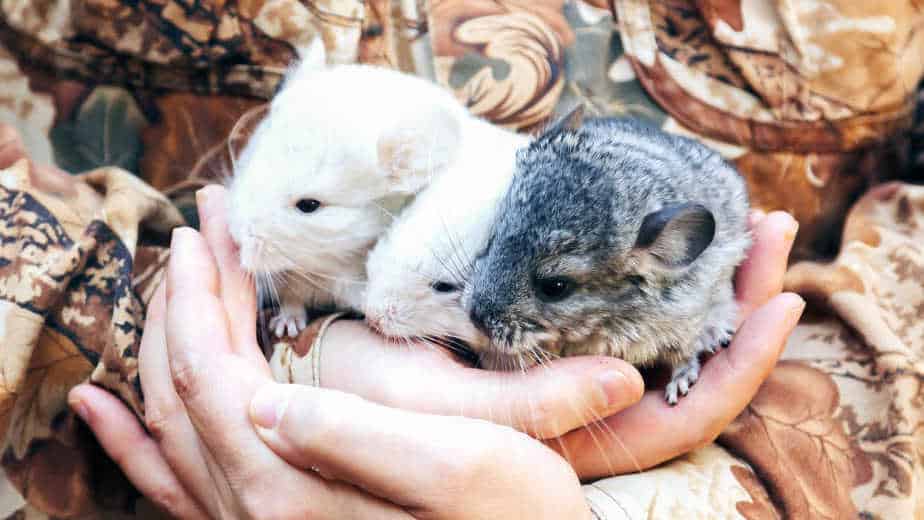
With baby chinchillas, you are going to have it done for you (for the most part). Baby chinchillas remain with their mother in the initial stages after birth and are referred to as kits.
For a short summary of the female birthing process, you can refer to my guide here.
However, something that can occur with chinchillas after giving birth is known as a chinchilla becoming orphaned.
This simply means a chinchilla gets excluded from the group, or does not have the ability to feed and be nurtured by the mother chinchilla.
While this sounds awful to think about, it is not the end of the world, assuming you are prepared to provide the care for the baby chinchilla until it reaches a sufficient age, size, and health.
Here is a quick look at the initial weeks after the mother chinchilla gives birth to her kits.
Brief Baby Chinchilla Timeline
This brief timeline will give you some idea of the major steps involved in caring for a baby chinchilla. We’ll go into much more detail on everything further down in the article.
7 Days Before Birth
One week prior to the mother chinchilla giving birth to her kits, you need to separate the mother and father chinchilla from one another.
Ideally, this is best performed by having a separate cage that you can keep near the other cage, if you prefer. They simply should not be in the same cage at this stage of the gestation period or they will mate again.
When you separate the father from the mother, you should also shrink your cage for the mother, or switch cages altogether.
This is easy with some cages, like the Critter Nation 2 Dual Level Cage, which is the one I use. You can simply remove the top section of the cage.
Or you can use any other 1 level cage with minimal bar spacing and a solid floor.
I would recommend using fleece liners on the bottom of the 1 level cage to provide the most comfort for the mother chinchilla and make the cage cleaning process that much easier on yourself.
First 4 Weeks
During this time, the kits will feed exclusively on their mother’s milk. You main duty is to monitor them and make sure they are healthy. Weight the every few days to ensure they are getting enough milk.
Any kits that get orphaned and do not get any milk, or that don’t seem to be handling the after-birth process well, will need to be fed manually. We’ll discuss how to do that further below.
4 To 12 Weeks
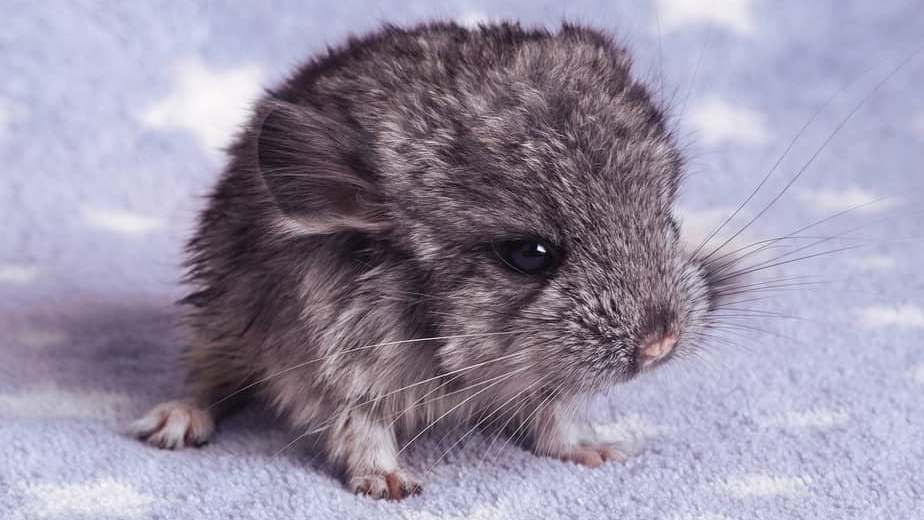
The weaning phase starts at week 4. The exact timeframe may vary from kit litter to kit litter. But overall, you can expect the baby chinchillas to stop relying on the mother’s milk around the 4 week mark.
During this time, it is imperative to actively monitor the babies and ensure they remain in good health.
During this phase, you are also going to begin feeding the chinchillas that have successfully weaned from the mother.
Providing hay is the best approach.
While you’ll find information out there that recommends other fresh alternatives, hay is a much safer bet, assuming you can get your baby chinchillas to cooperate.
This leaves no room for error by choosing a vegetable that may not be suitable for a chinchilla. And there are a lot of those. These animals have very sensitive digestive systems.
But I am not a vet. If you prefer to go the other direction on this, I highly recommend checking with a vet first.
It could also help a lot to read a few of my other blog posts detailing safe alternatives to chinchilla hay and chinchilla pellets.
You can read my post about which vegetables you can safely feed to a chinchilla here.
You can also read my post about which fruits are safe for a chinchilla here.
However, just stick to hay if your baby chinchillas are receptive. Trust me, it is easier and safer.
Week 12
The end of week 12 marks the finish line. No, this does not mean that the individual care and attention end at this time for the baby chinchillas.
But it does mean that the most worrisome days are now behind you. The young chinchillas are typically free of the mother and no longer dependent on her. In other words, they are all grown up and ready to live on their own.
How Baby Chinchillas Are Born
Although chinchillas may seem like an exotic or mysterious pet, there is nothing fancy about how a chinchilla gives birth. A chinchilla gives birth in the same fashion as most mammals.
A male chinchilla impregnates a female chinchilla during her receptive times of the year, which typically fall between November and May.
Once the female is pregnant, the chinchilla gestation period is about 111 days on average.
The baby chinchillas mature to a certain stage inside of the mother’s womb. Once the kits are born, they continue to depend on the mother for nutrients for about 12 weeks.
Baby Chinchilla Size And Weight
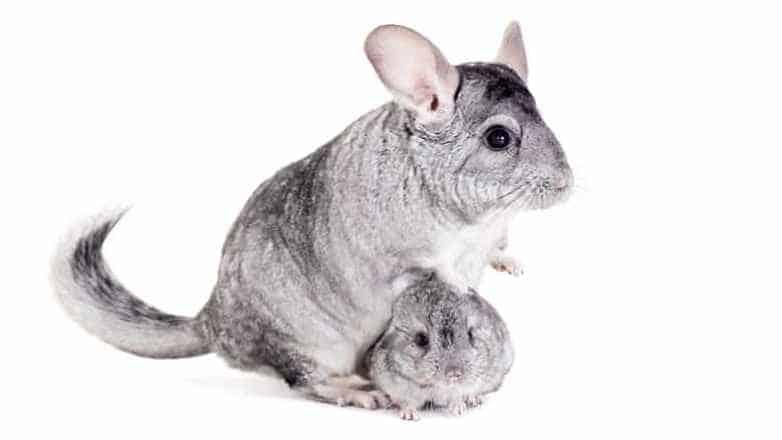
Part of ensuring that your baby chinchillas are healthy and getting the nutrients they need is ensuring that they are growing properly.
When you have an adult chinchilla, using the eyeball technique is often enough to ensure weight gain or weight loss is not taking place. But with baby chinchillas, you need exact numbers.
Especially if you have never dealt with, raised, or cared for a baby chinchilla in the past.
If you are about to find yourself being a new baby chinchilla parent, I highly recommend you invest in a scale like this one:
As you can see, it is not overly expensive and it will make your life much easier. You need to be keeping tabs on your chinchilla’s growth throughout the process.
You should weight the babies at least twice a week. Use a scale like the one referenced above, which is basically just a digital kitchen scale. Put a plastic bowl on top, in which you can place your baby chinchilla.
This part of the process is imperative, so do not think you can just skip it. This is especially true during the first 12 weeks.
The weighting process is simple, though perhaps a bit intimidating, if you have not done it before. Simply pick up the baby chinchillas and place them on the scale.
We will cover how to handle a baby chinchilla properly a bit further down in this post, to ensure you are comfortable and prepared with this part of the process.
Proper Weight Guidelines For Baby Chinchillas
As a rule of thumb, baby chinchillas should weigh approximately 30 to 60 grams. Typically, you want to see some size and weight to a baby chinchilla, as this usually indicates strong health and a good chance of making it to adulthood.
As your chinchilla continues to grow, the weight guidelines will change. I have a dedicated post discussing how much a chinchilla in adulthood should weigh that you can see here.
Keep in mind that all chinchillas are different.
While most chinchillas will be considered full-grown between 7 to 9 months, the weights may vary a bit between two different chinchillas and between male and female chinchillas.
If you are ever at a point where your chinchilla’s weight is becoming a genuine concern, you should speak to a local vet that has experience working with chinchillas to get further guidance on the issue.
Baby Chinchilla Not Gaining Weight
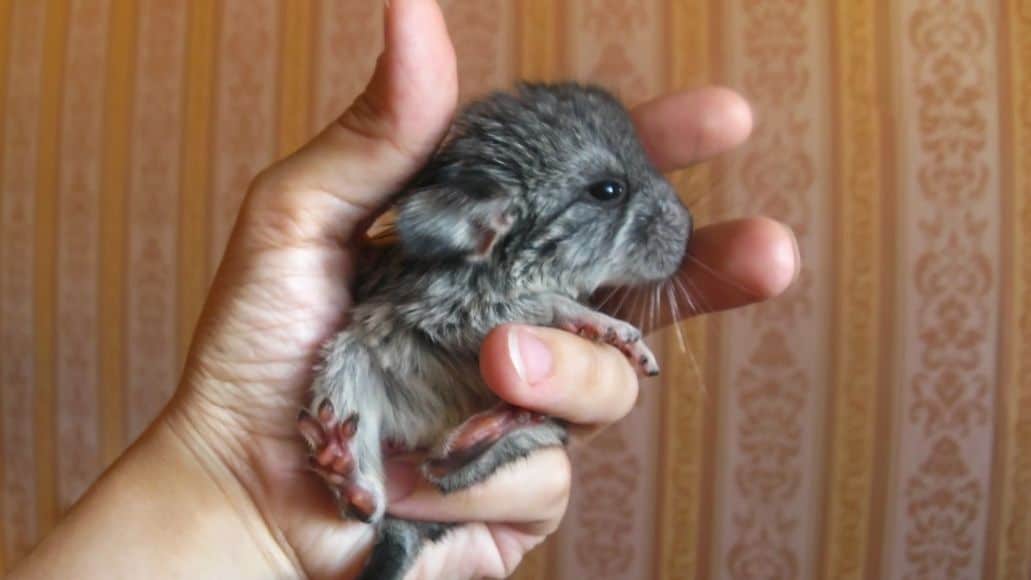
A baby chinchilla not gaining weight can be worrisome and indicate a problem, if your kits are not getting the nutrients that they need to survive and grow properly.
Most of the time, weight gain issues are like the problem that dogs sometimes have when they are pushed further from the mother.
They simply cannot compete against their siblings to get the milk and nutrients that they need, or the mother chinchilla is simply not producing enough milk to feed all her kits.
In some situations, it can even be due to an ill chinchilla, although this is typically not the case.
When this begins to happen, you need to intervene and begin manually feeding the baby chinchilla that is struggling with weight gain, to ensure it is getting the appropriate amount of milk and nutrients.
How To Take Care Of A Baby Chinchilla
So far, we have a basic understanding of the birth process and what happens for the 12 weeks following the birth, in addition to your role in the process.
Now, let us transition a bit and begin talking about the general rules of providing the best care possible to baby chinchillas.
As discussed thus far, we know that baby chinchillas will need to remain with their mother for roughly 12 weeks.
This is also the 12 weeks where a good majority of the care and nutrients are being provided by the mother chinchilla, which reduces your involvement to intervention and active monitoring.
However, after this 12-week period has passed, you still have work to do and care to provide towards your baby chinchillas.
The care begins with the separation from the mother at the 12-week mark, or around that time when you deem it appropriate to do so.
To separate your chinchillas properly, you want to place the males together and the females together. The males and females should not be together in the same cage. This can result in inbreeding and more baby chinchillas.
Clearly, at this point, if we do the math, we are looking at a minimum of 4 cages needed.
- One for the father chinchilla who cannot be around the mother chinchilla or the female baby chinchillas
- One for the male babies
- One for the female babies
- And of course, one for the mother chinchilla.
Always remember to complete this separation of the opposite sexes. If you’re not sure what gender your new babies are, ready our article on how to tell the sex of a chinchilla.
Once you have done this, you are also going to want to monitor the interaction between the brothers and between the sisters.
Sometimes, chinchillas bond with other chinchillas flawlessly and thrive together, and sometimes they do not.
If any of the chinchillas are showing aggression towards a sibling of the same sex in the same cage, they will also need to be separated.
At this time, you can begin the transition into providing care for your baby chinchillas, much like you would provide the care for adult chinchillas, but with a bit more monitoring needed.
You will be able to begin offering chinchilla hay. You can also use specially formulated pellets now for your young chinchillas.
You also want to ensure you have plenty of water accessible for your chinchillas, which may require several water bottles to be attached to the cage.
Additionally, you are going to need all the other chinchilla accessories inside of the cage (more on this shortly).
I also want to refer you to my chinchilla care guide for adult chinchillas for more detailed information. You can find that here.
Also, you might want to check out my eBook, that provides a complete care guide, including critical mistakes you need to avoid during your chinchilla ownership.
You can learn more about the eBook offer here.
We will discuss the rest of the needed items for your chinchillas further into this post.
How To Get A Baby Chinchilla
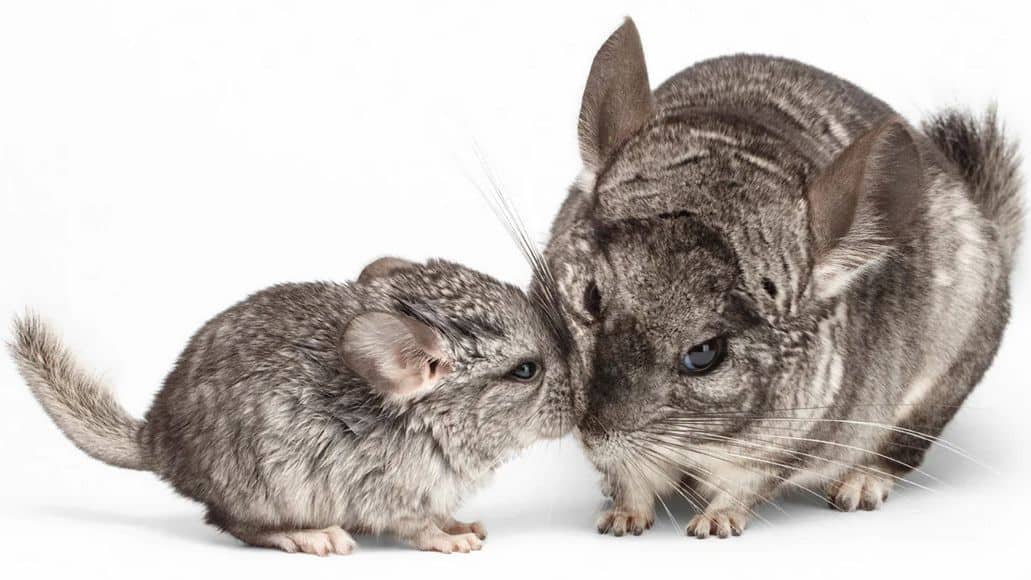
To get a baby chinchilla, you obviously have the option of having a male and female chinchilla breed on your own.
If this is not the path you were desiring to take and were curious if you can just adopt a baby chinchilla, here is the deal.
To get a younger chinchilla than the average, the only other option you will likely have is working with a local chinchilla breeder.
PetSmart and Petco typically do not offer chinchillas at ages younger than 8 months.
This is not something to be discouraged over, but just makes it a bit more difficult to get a baby chinchilla. It basically leaves you with two options: breed the baby chinchillas on your own or adopt from a local breeder.
Baby Chinchilla Pricing And Ongoing Cost
When you purchase a baby chinchilla, the cost is going to vary based on the color or mutation of the chinchilla you desire.
Here is a quick look:
- Standard grey: $150 to $200
- TOV (touch of violet) ebony: $300 to $400
- Beige: $300 to $400
- Violet: $300 to $400
- Black or pearl: $750 to $1000
- Blue Diamond: $750
- White: $500 to $600
After you have decided on the color of the baby chinchilla you are interested in, you will have other ongoing costs that will need to be considered as well.
These include common items such as:
- Food
- Accessory and toys
- Bedding
- Treats
Overall, if you ask my opinion, chinchillas are one of the most cost-friendly pets you can own.
I feel like I am not spending money often on my chinchilla, unless it is to test something new or because I simply want to spoil her.
Best Cages For Baby Chinchillas
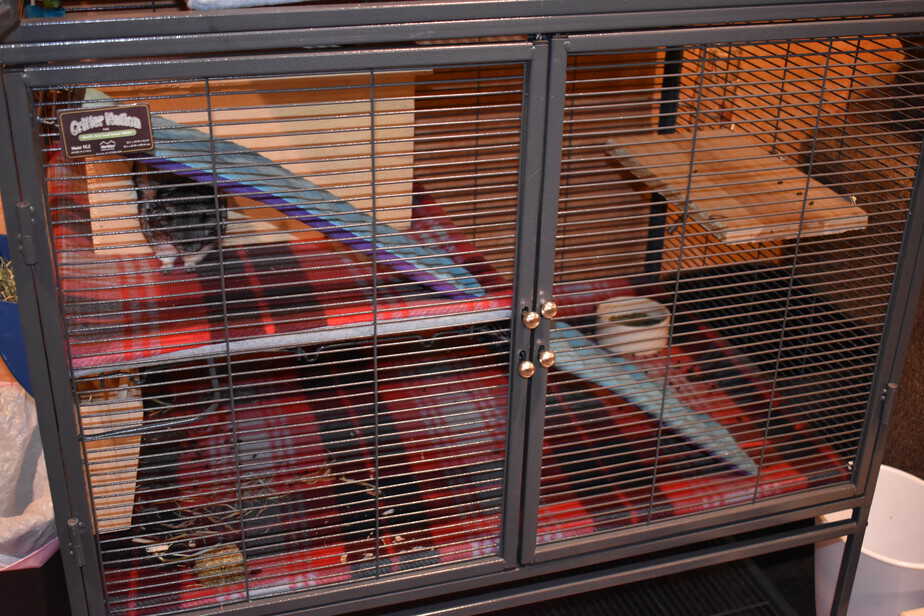
Part of providing the best care possible for a chinchilla requires that you put together an excellent chinchilla cage for them.
I have plenty of recommendations as to which cages. I recommend. I rank the best cages here.
The number one recommendation in that article is the cage I use myself, which I already mentioned further up in this post.
It is important that you provide plenty of vertical space and load the cage with plenty of chew friendly and safe items for them to keep their teeth healthy.
Dust Baths And Baby Chinchillas
Avoid dust baths during the initial days after your baby chinchillas are born.
However, as your baby chinchillas progress and begin gaining weight at the correct pace, it will be okay to begin offering them a dust bath when they are around 10 days old in most circumstances.
For the best results, offer the dust bath to the mommy chinchilla at the same time, and allow them to enjoy themselves in the dust bath, getting clean and rolling around as a family.
Food Options For Baby Chinchillas
As you have probably figured out thus far into this post, the food that is ideal for a baby chinchilla comes straight from the mother in the form of milk.
After that 12-week period is over, you begin offering your chinchilla the basic timothy hay and pellets. You can also use other items such as hay cubes to offer your chinchilla.
Even though they drink their mother’s milk, once they are weened off it, you should not feed them any dairy products. Many people assume chinchillas can eat cheese because they are rodents, but that is not the case.
Handling And Interacting With Baby Chinchillas
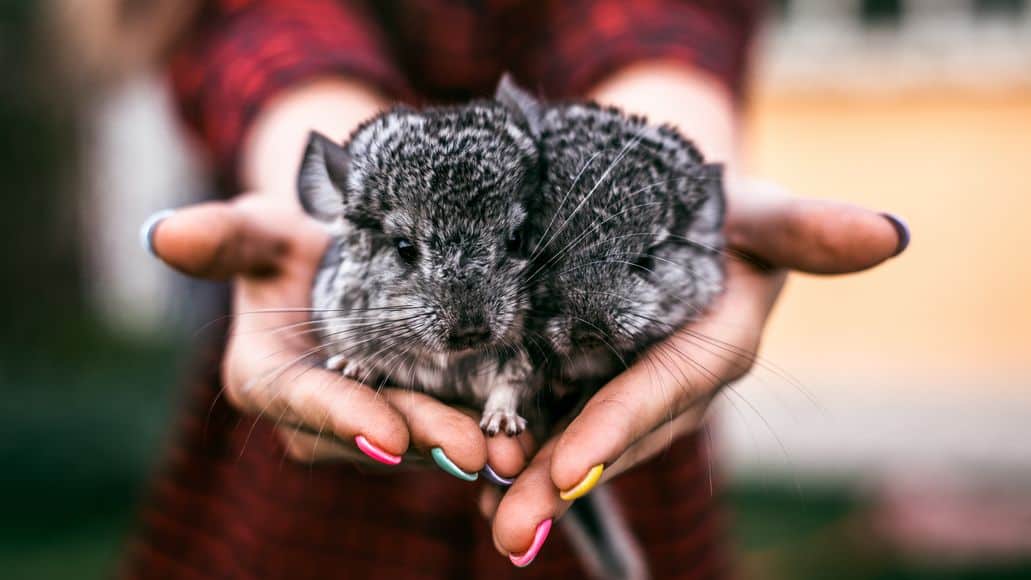
Handling a baby chinchilla is much like handling an adult chinchilla. You need to be gentle due to how fragile a chinchilla’s body is. Especially when they are young.
The best way to do so is to pick up your chinchilla while supporting the butt and supporting it from underneath.
If it is too difficult to get a good handle on your baby chinchillas using this method, picking up your chinchilla by the base of the tail is perfectly fine.
Once you have a good handle of them, you can draw them close to your body for additional support and comfort for your chinchilla.
Avoid handling a baby chinchilla for too long, to ensure they do not get too hot, stressed, or scared.
You also need to understand that some chinchillas will simply not enjoy being handled while others will. It is part of the process, and all chinchillas are different in this respect.
You can also refer to my post here that is specifically meant to help you get your chinchilla to enjoy being held.
Miscarriages With Chinchillas
Chinchillas do have miscarriages. Miscarriages with chinchillas occur most frequently due to illness, improper diets, and genetic problems with a new kit. Stress is also a possible cause of miscarriages.
When a chinchilla gives birth, it should be relatively clean and not much blood outside of the placenta.
If, however, this is not what you experience and more blood than usual is appearing, it is best to get to a vet immediately.
Not treating issues with a pregnancy on a mother chinchilla can result in death for the mother and the kits.
How To Care For Baby Chinchillas: Final Thoughts
Chinchillas are adorable pets and are relatively easy to care for.
It is no wonder why so many individuals are interested in baby chinchillas and want to learn the ropes to provide the best care possible for them.
I am in the same boat and advocate for anyone considering adopting a chinchilla, to go ahead and do it. It will be an excellent experience and you will form a lasting bond.
Chili and I wish you the best of luck with your baby chinchillas and the journey ahead of you.
Share your thoughts.
Do you have any further information you can share with the Planet Chinchilla community to help us all provide better care for our baby chinchillas?
Any other advice about raising a baby chinchilla you believe to be relevant?
Be sure to share those thoughts, stories, and concerns by dropping a comment below.
As always, Chili and I wish you the best of luck and appreciate you stopping by and reading today.

Leave a Reply